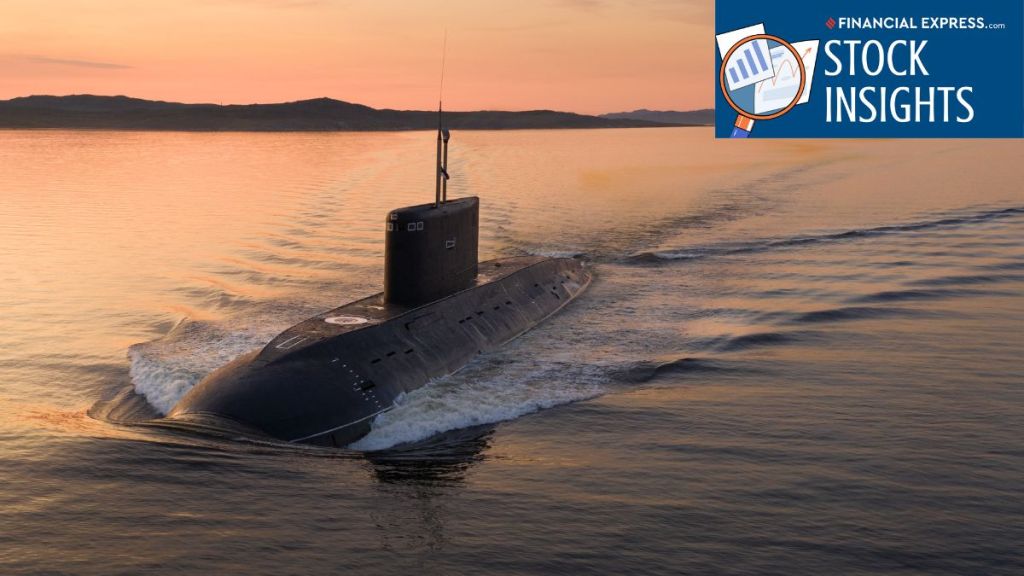India’s submarine story is entering a new chapter.
The Navy’s current fleet rests on the Kalvari-class, built at Mazagon Dock Shipbuilders (MDL) under the first Project-75 in partnership with France’s Naval Group.
Six of these modern Scorpene-variant submarines are now in service or close to induction. This program not only gave India cutting-edge diesel-electric submarines but also helped MDL revive its submarine-building expertise.
Now, the government is ready to go a step further.
On 23 August, the Cabinet Committee on Security cleared negotiations for six new submarines under the long-awaited Project-75(I), to be built with Germany’s ThyssenKrupp Marine Systems (TKMS).
What’s the Big Shift?
Unlike the Scorpenes, which were built without Air Independent Propulsion (AIP) and remain dependent on diesel generators, the new German boats will come equipped with fuel-cell AIP technology from day one.
TKMS has decades of proven expertise here — their submarines can stay underwater silently for up to two to three weeks at a stretch. For India, this means no waiting for retrofits or untested indigenous systems — the stealth edge is built in.
With a project cost of Rs 700 billion (bn), Project-75(I) isn’t just about submarines. It’s about a technological leap, a deeper transfer of know-how, and putting Indian shipbuilding firmly on the global map.
After being stuck for over six months, the centre has given clearance to begin negotiations for the deal. At the centre of this landmark project is Mazagon Dock Shipbuilders.
#1 Mazagon Dock Shipbuilders
Mazagon Dock is the only shipyard company to have received Navratna status.
Mazagon Dock Shipbuilders Limited (MDL) is one of India’s leading shipbuilding yards, headquartered in Mumbai and operating as a premier government-owned entity under the Ministry of Defence.
Since 1960, MDL has delivered over 805 vessels, including more than 30 warships, from guided-missile destroyers to advanced stealth frigates, and 8 submarines.
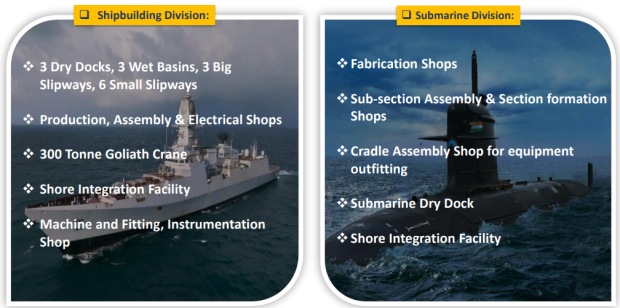
It has evolved for more than two centuries into a major industrial complex with advanced shipbuilding and submarine construction capabilities.
- Major Submarine Milestone
On 9 January 2025, MDL handed over INS Vaghsheer, the sixth and final Scorpene-classsubmarine under Project-75, completing the series of Kalvari-class boats built in partnership with France’s Naval Group.
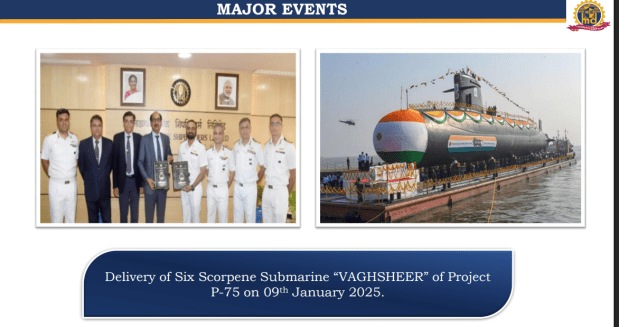
The full fleet includes:
- INS Kalvari
- INS Khanderi
- INS Karanj
- INS Vela
- INS Vagir
- INS Vaghsheer
This achievement underscores MDL’s unmatched submarine-building expertise—positioning it perfectly for India’s next big naval leap.
- The Next Big Opportunity
According to the media report, the Ministry of Defence has granted approval to initiate cost negotiations with Germany’s TKMS for the construction of six submarines under the Rs 700 bn Project 75(I) initiative.
According to the reports, negotiations are expected to begin soon, with the final contract likely to be awarded to the Mazagon Dock–Thyssenkrupp consortium around six months after successful completion of the talks.
- Order Book Snapshot
Mazagon Dock Shipbuilder’s Order book as of 31 March 2025, stands at Rs 322.6 bn.
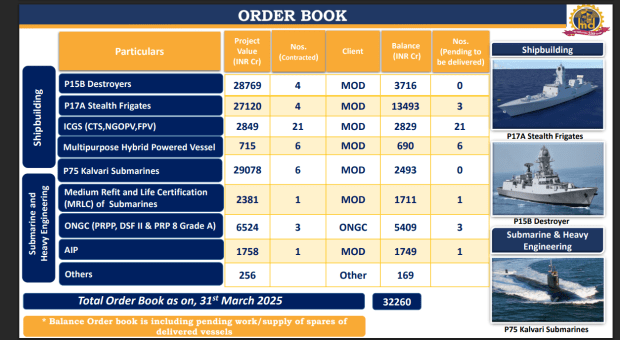
Out of Mazagon Dock Shipbuilders’ total order book, the submarine and heavy engineering division contributes Rs 113.62 bn, accounting for about 35.2% of the total.
Meanwhile, the shipbuilding division makes up the larger share with Rs 207.28 bn, representing nearly 64.3% of the overall orders.
- A Look at the Financials
The company’s revenue rose 11.4% YoY in Q1 FY26. Meanwhile, net profit declined to Rs 4,193 m in the same period, from Rs 6,659 m a year back.
The company is nearly debt-free and has shown steady growth over the past few years.

From FY21 to FY25, its revenue registered a CAGR of around 14%, while profit after tax grew at a much faster pace with a CAGR of nearly 38%.
It also boasts an impressive 3-year return on equity (ROE) of 32.4% and maintains a healthy dividend payout of 33.5%.
Nuclear Submarine Program
Alongside P-75I, India is also pursuing two nuclear attack submarines (SSNs).
The government is exploring options to fast-track both nuclear and conventional submarine projects, recognising their strategic importance in the region.
The government is accelerating nuclear-powered attack submarine (SSN) programme under Project-77, with two submarines now officially cleared for development.
Ultimately, India plans to manufacture a fleet of six SSNs that can stay underwater for a longer period of time compared to traditional diesel-electric submarines and travel at high speed.
These advanced submarines will be equipped with the next generation of weapons, which will be away from traditional sub-Sonic cruise missiles to include supersonic and hypersonic cruise missile systems.
The private sector player that is expected to play a major role, in collaboration with the Navy’s Submarine Building Centre is Larsen & Toubro (L&T).
#2 Larsen & Toubro (L&T)
L&T is one of Asia’s largest vertically integrated engineering, procurement, and construction companies. The company’s operations span across sectors such as power, infrastructure, hydrocarbons and heavy engineering.
L&T PES leverages its three decades of design and manufacturing experience in submarine construction to offer turnkey solutions.
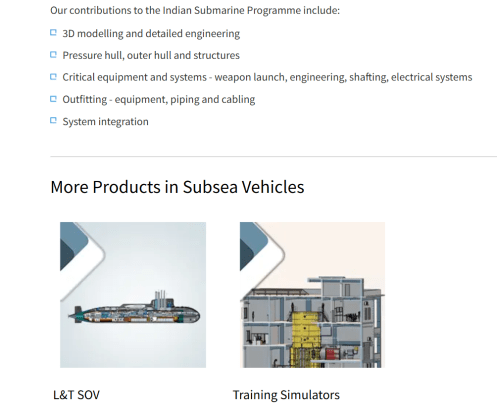
The design and construction processes are CMMI level 3 certified, with dedicated R&D centres for design of platforms and equipment and state-of-the-art submarine production centres at Hazira and Kattupalli.
- The Next Big Opportunity
This is not L&T’s first foray into submarine construction. The company was also involved in building India’s Arihant-class submarines, which are designed to carry nuclear missiles.
With its proven expertise and infrastructure, the government might place its trust in L&T for the next-generation submarines.
L&T has contributed significantly to the design and manufacture of hulls and pressure compartments for nuclear submarines in the past. For Project-77, the company is expected to build critical components at its dedicated facility in Hazira, Gujarat.
These subs are expected to carry an evolved version of the BrahMos missile and future hypersonic systems currently under development by DRDO.
- A Look at the Financials
In Q1 FY26, the company’s revenue rose 16% YoY to Rs 63.7 bn, while profit after tax (PAT) rose 30% YoY to Rs 36.2 bn.

From FY21 to FY25, its revenue registered a CAGR of around 12%, while profit after tax grew at a CAGR of 11.7%.
Conclusion
With these progresses, the Indian Navy is ready to significantly strengthen its underest war capabilities, promoting both strike power and detention in the Indo-Pacific.
This strategic step not only enhances the country’s defense readiness, but also ensures that it is ready for new security challenges in an election that contested.
Naturally, such developments are expected to raise investor’s spirit around defense manufacturing shares.
Disclaimer: This article is for information purposes only. It is not a stock recommendation and should not be treated as such. Learn more about our recommendation services here…
The website managers, its employee(s), and contributors/writers/authors of articles have or may have an outstanding buy or sell position or holding in the securities, options on securities or other related investments of issuers and/or companies discussed therein. The content of the articles and the interpretation of data are solely the personal views of the contributors/ writers/authors. Investors must make their own investment decisions based on their specific objectives, resources and only after consulting such independent advisors as may be necessary.
